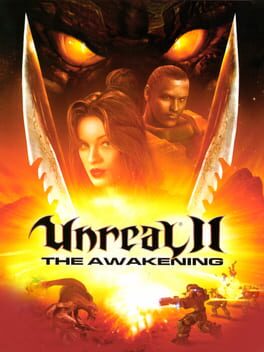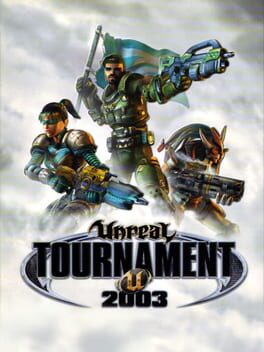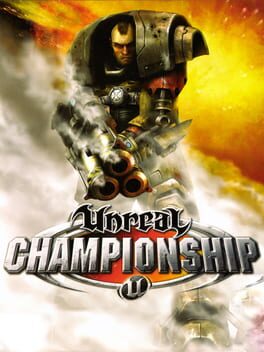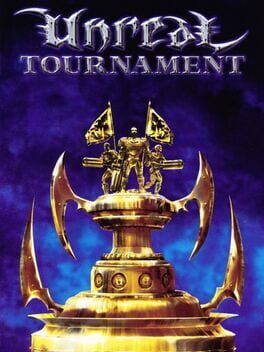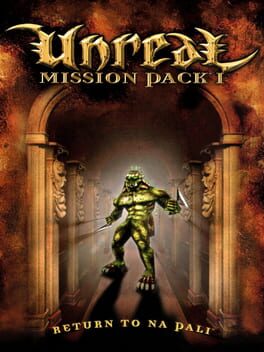

Your prison ship has crash-landed on the fastest, sleekest, most dangerous 3D world ever created. Look around, crystal clear water shimmers, shadows dance and shift, alien architecture fades into the horizon. Discover the secret of this mysterious planet and find out what caused a peaceful race to be enslaved by vicious merciless aggressors.
Also in series
Reviews View More
Have you ever felt a burning hatred for a billionaire dollar corporation in your soul like me? You probably have, it's an unfortunately common feeling nowadays. But Unreal was something incredible. Something beautiful. Some of the best aesthetics in any game ever. I'm too young to appreciate the feeling of experiencing the mindblowing 1998 beauty of Na Pali on a Voodoo2 card. But even still, seeing that as a 20 year old in 2023 was incredible. The aesthetics have aged so beautifully, rivaling even Half-Life 1. And that's only a small fragment of the experience. The gunplay is immaculate…if a little janky. Not having a reload button is weird, especially after the Marathon trilogy made everyone hate that concept, but it's at least easy to reload the pistol by just quickswapping. Even still, all the weapons are beautifully balanced and designed. None of them ever feel outdated, obsolete, over or underpowered. The enemies feel especially tough to fight, thanks to the incredible AI based off of Quake deathmatch player data. But it never feels hopeless against any of them. You can very easily outsmart the AI, and it's not all that tough to figure out how. One complaint however. That goddamn dodge button. I'd rather have it than not, but it feels so finicky, like it only ever kinda works when I want it to. It's still a cool addition. Oh, and how about that MUSIC?! It's really hard to describe the Unreal soundtrack. Electronica…ambient…progressive rock…techno…DnB/jungle…? I don't know what it is, but I love it. It works wonders with the combat and aesthetics of the world, and vice versa. Unreal is an incredible experience that Tim Sweeney doesn't want you to have. And he should rot in hell for that. But there are still ways to get it if you know where to look. And you absolutely should look for it. It's called Unreal. Because it is.
The OG immersive FPS and the very start of the Unreal engine, often unfairly forgotten and usually overshadowed by Half-Life!
But yeah, Unreal came out earlier in 1998 and is a mind-blowing milestone of the FPS genre with incredible graphics and gameplay for its time. What might seem like a glorified tech-demo for the engine, Unreal is a surprisingly well-designed immersive FPS, keeping you fully in first-person mode without any cutscenes in a 10-12 hour long story in a futuristic setting on an alien planet.
The game popularized many elements which became pretty much staples of later FPS games including secondary fire modes for weapons, switch-puzzles, dark areas, underwater sections, grand landscapes with alternate routes, surprisingly intelligent enemies (dodging out of your non-hitscan projectiles), ally NPCs and mood-dependent dynamic music!
It holds up surprisingly well even today, many of its maps just scream ATMOSPHERE with the beautiful visual style and the fantastic ambient soundtrack by Alex Brandon and co.
It does suffer from some dated concepts and some minor inconveniences such as the forced dark areas with limited flashlight durations, overly long maze-like areas with annoyingly hidden switches, very health-spongy enemies at the later parts and a bit unbalanced weapon arsenal (Flak Cannon FTW!) The main story also becomes a bit dull by the midpoint, though the beginning is extremely strong with legendary scenes like the ambush in Rrajigar mine! Return to Na Pali is much better paced but overall there's not much to remember from the story, it's just simple "Get to the end and survive".
It might not have aged that well and not became that memorable as Half-Life but it's a very important title in PC gaming for both Epic Games and the FPS-genre in general, not to mention that it spawned Unreal Tournament a year later, which is an all-time classic of arena shooters and one of the best PC games of all time!
But yeah, Unreal came out earlier in 1998 and is a mind-blowing milestone of the FPS genre with incredible graphics and gameplay for its time. What might seem like a glorified tech-demo for the engine, Unreal is a surprisingly well-designed immersive FPS, keeping you fully in first-person mode without any cutscenes in a 10-12 hour long story in a futuristic setting on an alien planet.
The game popularized many elements which became pretty much staples of later FPS games including secondary fire modes for weapons, switch-puzzles, dark areas, underwater sections, grand landscapes with alternate routes, surprisingly intelligent enemies (dodging out of your non-hitscan projectiles), ally NPCs and mood-dependent dynamic music!
It holds up surprisingly well even today, many of its maps just scream ATMOSPHERE with the beautiful visual style and the fantastic ambient soundtrack by Alex Brandon and co.
It does suffer from some dated concepts and some minor inconveniences such as the forced dark areas with limited flashlight durations, overly long maze-like areas with annoyingly hidden switches, very health-spongy enemies at the later parts and a bit unbalanced weapon arsenal (Flak Cannon FTW!) The main story also becomes a bit dull by the midpoint, though the beginning is extremely strong with legendary scenes like the ambush in Rrajigar mine! Return to Na Pali is much better paced but overall there's not much to remember from the story, it's just simple "Get to the end and survive".
It might not have aged that well and not became that memorable as Half-Life but it's a very important title in PC gaming for both Epic Games and the FPS-genre in general, not to mention that it spawned Unreal Tournament a year later, which is an all-time classic of arena shooters and one of the best PC games of all time!
It's unreal how your entire arsenal is useful in this game, no gun is redundant or useless. The ever-changing scenarios encourage you to swap weapons often and make use of the different options available. A lot of the foes can dodge your shots and move in unpredictable ways, while the bulk of damage is done by projectile weapons. This creates situations in which short-term planning is essential according to the type of enemy you’re facing. Some of the monsters, for example, start attacking from mid-range and attempt to get in your face as you back away. You can’t use explosive weapons when a 3-meter beast has its crotch pressed against your head, or else you would take severe damage. A good course of action is dealing enough explosive damage while the enemy is far away so that you can finish it off with a flak cannon (shotgun, basically) when it's up close. Of course, since the AI will almost always attempt to dodge your rockets/grenades, you should try forcing it into a situation in which it doesn’t have room to move away. If there’s more than one enemy, you might want to prioritize the ones which do more damage; or find ways to damage multiple at the same time. In a vacuum, this works well, creating a combat loop that is less about managing hordes or reacting to predictable patterns, and more about quickly adapting to factors outside of your immediate control to take back dominance over the playing field. Your enemies can take a lot of hits, so a fight against even one, depending on the context, can be a real struggle. The problem with Unreal’s combat is that the level design doesn’t always support its unique enemy behavior.
When the area of play is too expansive, most of the interesting mechanics are nullified, since both you and your enemies have functionally infinite space to avoid projectiles. Hitscan weapons become your most reliable solution. Monsters, however, are stuck with projectile-based attacks, so the encounter becomes tensionless, as nothing is being actively fought over.
A claustrophobic area can work, as long as it draws the players in instead of pushing them away. There are a lot of opportunities to corner the AI, but you’re equally susceptible to having your movement options restricted. Tight spaces test the player’s quick-thinking skills and smart use of the environment. You want to keep the monster at medium range while utilizing the level geometry and movement to avoid damage. Sometimes, though, you have to force yourself into uncomfortable situations to fully enjoy this type of design. It’s too easy for the player to take an overly defensive approach and not even enter the stage, standing by the entrance and engaging with the enemy from behind a safe corner. To avoid this, the designer could attract the player into the battlefield by providing a safe area inside the field itself (such as cover), or introduce the enemies only after the player is already in the middle of the stage, perhaps in a more challenging position. The key is to make players move around and strategize a short-term course of action. Locking the exits can feel cheap if the game puts emphasis on organically exploring the environment, you don’t want to take away too much agency. The other solutions work by letting the player be a protagonist of their experience while still leading them to interesting scenarios.
This game would benefit from stages structured more like smaller, less cyclical multiplayer levels. A larger area consisting of a series of interconnected tight or slightly open sections that allow for layered options of engagement with the enemy. The loop asks for creative use of the environment, so geometry is key. Different levels of verticality, narrowness and amount of cover could all be used to define battles, but zones this thought-out are rare and isolated.
Outside of combat, stages consist of the classic old rhythm of finding triggers to unlock the rest of the level, which forces exploration and clever analysis of the environment. I am terrible navigating most games that use this structure, so it may be a personal issue, but I found Unreal to be very confusing at times. For a good portion of my playthrough, I was ready to praise the game for always, somehow, leading me to the right path and guaranteeing steady progression without requiring me to bang my head against the wall. After many moments stuck, however, I realized that I only had that impression because I had happened to bang my head against the right walls by luck. The set of actions you’re required to figure out and perform get more complicated as the levels grow. By the last third, you’re swimming through sewers and running back and forth between castles, outposts and houses in order to find the one lever you haven’t pushed to activate a lift on the other side of the map. The tips that appear on the translator help, but they can’t replace clear, well-signposted design, which is mostly lacking. It’s Unreal-istic to expect the player to keep track of every door they must backtrack to in order to progress. When you flip a switch, you shouldn’t be left wondering what in god’s name it did. To avoid confusion, it’s good, for example, to make sure the player has a view of the section they’re altering when activating a trigger.
The game maintains a very strong visual cohesion while keeping levels diverse and innovative. It’s truly unreal just how varied the areas can look, considering the game is quite long (I took a few screenshots to exemplify - https://imgur.com/a/jPsmllp). The aesthetic vision incorporates ancient dungeons, sci-fi motherships and organic forest environments into a believable, consistent world. The striking art direction is a solid foundation for its universe. The concept alone is already half the world-building: peaceful natives inhabit a functioning ecosystem, living in harmony with the forces of nature, only to have their way of life destroyed and exploited by foreign, technologically oppressive invaders. The rest is detailed by clever set dressing and rare but remarkable written content. Experiencing a story through observation helps construct a believable environment. Also, it’s interesting how small you are compared to the rest of the creatures, it helps sell the idea that you are an alien in this world.
The soundtrack manages to translate a world of jungles, ancient principles and alien technology into a dense atmosphere. The more ambient tracks remind me of a modern vaporwave album, テレパシー能力者 : ロストエデンへのパス by Telepath and Nmesh, which also establishes an unreal, dream like ambience thematically focused on nature.
Unreal had everything to develop impeccable, intensely memorable combat encounters, but the rarity of stage design that understands its own enemies severely hurts its potential. It’s still a very fun experience that manages to keep itself entertaining even during the boring gameplay sections. The art direction is so cohesive and aesthetically pleasing, it’s unreal!
When the area of play is too expansive, most of the interesting mechanics are nullified, since both you and your enemies have functionally infinite space to avoid projectiles. Hitscan weapons become your most reliable solution. Monsters, however, are stuck with projectile-based attacks, so the encounter becomes tensionless, as nothing is being actively fought over.
A claustrophobic area can work, as long as it draws the players in instead of pushing them away. There are a lot of opportunities to corner the AI, but you’re equally susceptible to having your movement options restricted. Tight spaces test the player’s quick-thinking skills and smart use of the environment. You want to keep the monster at medium range while utilizing the level geometry and movement to avoid damage. Sometimes, though, you have to force yourself into uncomfortable situations to fully enjoy this type of design. It’s too easy for the player to take an overly defensive approach and not even enter the stage, standing by the entrance and engaging with the enemy from behind a safe corner. To avoid this, the designer could attract the player into the battlefield by providing a safe area inside the field itself (such as cover), or introduce the enemies only after the player is already in the middle of the stage, perhaps in a more challenging position. The key is to make players move around and strategize a short-term course of action. Locking the exits can feel cheap if the game puts emphasis on organically exploring the environment, you don’t want to take away too much agency. The other solutions work by letting the player be a protagonist of their experience while still leading them to interesting scenarios.
This game would benefit from stages structured more like smaller, less cyclical multiplayer levels. A larger area consisting of a series of interconnected tight or slightly open sections that allow for layered options of engagement with the enemy. The loop asks for creative use of the environment, so geometry is key. Different levels of verticality, narrowness and amount of cover could all be used to define battles, but zones this thought-out are rare and isolated.
Outside of combat, stages consist of the classic old rhythm of finding triggers to unlock the rest of the level, which forces exploration and clever analysis of the environment. I am terrible navigating most games that use this structure, so it may be a personal issue, but I found Unreal to be very confusing at times. For a good portion of my playthrough, I was ready to praise the game for always, somehow, leading me to the right path and guaranteeing steady progression without requiring me to bang my head against the wall. After many moments stuck, however, I realized that I only had that impression because I had happened to bang my head against the right walls by luck. The set of actions you’re required to figure out and perform get more complicated as the levels grow. By the last third, you’re swimming through sewers and running back and forth between castles, outposts and houses in order to find the one lever you haven’t pushed to activate a lift on the other side of the map. The tips that appear on the translator help, but they can’t replace clear, well-signposted design, which is mostly lacking. It’s Unreal-istic to expect the player to keep track of every door they must backtrack to in order to progress. When you flip a switch, you shouldn’t be left wondering what in god’s name it did. To avoid confusion, it’s good, for example, to make sure the player has a view of the section they’re altering when activating a trigger.
The game maintains a very strong visual cohesion while keeping levels diverse and innovative. It’s truly unreal just how varied the areas can look, considering the game is quite long (I took a few screenshots to exemplify - https://imgur.com/a/jPsmllp). The aesthetic vision incorporates ancient dungeons, sci-fi motherships and organic forest environments into a believable, consistent world. The striking art direction is a solid foundation for its universe. The concept alone is already half the world-building: peaceful natives inhabit a functioning ecosystem, living in harmony with the forces of nature, only to have their way of life destroyed and exploited by foreign, technologically oppressive invaders. The rest is detailed by clever set dressing and rare but remarkable written content. Experiencing a story through observation helps construct a believable environment. Also, it’s interesting how small you are compared to the rest of the creatures, it helps sell the idea that you are an alien in this world.
The soundtrack manages to translate a world of jungles, ancient principles and alien technology into a dense atmosphere. The more ambient tracks remind me of a modern vaporwave album, テレパシー能力者 : ロストエデンへのパス by Telepath and Nmesh, which also establishes an unreal, dream like ambience thematically focused on nature.
Unreal had everything to develop impeccable, intensely memorable combat encounters, but the rarity of stage design that understands its own enemies severely hurts its potential. It’s still a very fun experience that manages to keep itself entertaining even during the boring gameplay sections. The art direction is so cohesive and aesthetically pleasing, it’s unreal!

